|
Clicking Stream Frog (Strongylopus grayii) |
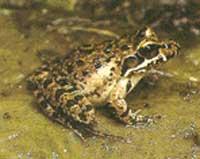 |
-
Breeds well in any puddle of water that is well supplied with vegetation
-
Can even breed in brackish pools near the sea
-
As the name indicates, their call is a wooden tapping sound - repeated monotonously
|
|
Leopard Toad (Bufo pardalis) |
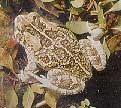 |
-
One of the largest southern African toads
-
Up to 13.5 cm long, but more commonly 5 to 7.5 cm long
-
Said to make a short soft grunt, much like a drawn-out snore, audible only at about a metre away
|
|
Painted Reed Frog (Hyperolius marmoratus) |
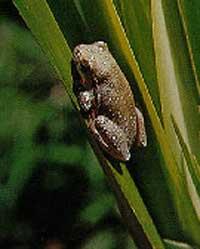 |
-
Quite small, growing up to 2.8 cm in length
-
Their colouration is very variable - there are several subspecies listed
-
Their call is a shrill, high pitched whistle, rapidly repeated
-
Often seen hiding under leaves in the daytime
-
They do well in urban environments
|
|
Helmeted terrapin (Pelomedusa subrufa) |
 |
-
Seldom exceeds 30 cm in length
-
It is a very common species in freshwater pans - even in arid areas such as the Karoo
-
Omnivorous and may even take birds (such as doves) when they come to the waters' edge
|
|
Angulate Tortoise (Chersina angulata) |
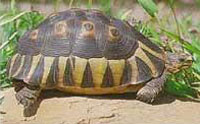 |
-
Frequently seen on campus and on the trail
-
Grows to a maximum size of 30 cm
-
Their diet includes grasses, shrubs and succulents
-
These tortoises have a home range - males will spar ferociously when defending their territories
-
Combat involves butting and using the enlarged shell plate under the neck to overturn one another
|
|
Mountain Tortoise or Leopard Tortoise (Geochelone pardalis) |
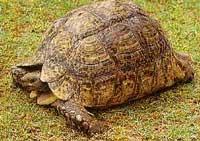 |
-
Largest tortoise in southern Africa
-
Can achieve lengths of 72 cm and weigh 40 kg
-
Feeds on grass, shrubs and succulents - may gnaw on bones to obtain sufficient calcium for its shell
-
They have a large home range (1-2 square km) and will defend it vigorously
|
|
Spotted Thick-toed Gecko (Pachydactylus maculatus) |
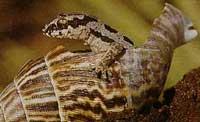 |
-
Small gecko, here seen hiding in the shell of a Giant African Snail (Achatina fulica; max 15-20 cm)
-
Reach a maximum length of 11 cm - several of them may crowd into a big snail shell during winter
-
Feed at night on small insects and spiders
-
They live for 3 to 4 years
|
|
Common or Rhombic Eggeater (Dasypeltis scabra) |
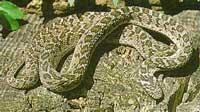 |
-
A common snake known to occur throughout southern Africa - however, it is seldom seen
-
Egg eating snakes have several adaptations of the head and jaws - make it possible for them to eat eggs of up to three time the diameter of their heads
-
Special teeth in the gullet saw through the shell as it is being swallowed, allowing the liquid part of the egg to be extracted
-
The collapsed shell is spat out
-
Only fresh eggs are eaten
|
|
Slug Eater (Duberria lutrix) |
 |
-
Common and inoffensive species
-
A great help to gardeners - it eats slugs and other garden pests
-
When alarmed it rolls into a tight spiral
-
Reaches a maximum length of 43 cm
|
|
Mole Snake (Pseudaspis cana) |
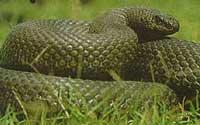 |
-
A large (max. length 210 cm), thick snake
-
Harmless constrictors - can be very useful in controlling the populations of mice and rats
|
|
Olive House Snake (Lamprophis inornatus) |
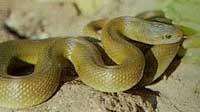 |
-
Reaches a maximum length of 130 cm
-
Prefers slightly more moist habits than the Brown House Snake
-
Eats rodents and may also eat other smaller snakes
|
|
Brown House Snake (Lamprophis fuliginosus) |
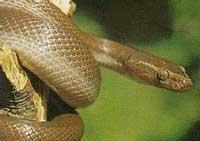 |
-
The largest of the House Snakes (max. length 150 cm)
-
Quite a handsome snake with two pale yellow streaks down the sides of the head
-
Like Mole Snakes, House Snakes will attack when provoked or handled - are easy to tame once they calm down
-
As the name suggests they were kept in, or encouraged near houses and granaries to eat rats and mice
|
|
Spotted or Rhombic Skaapsteker (Psammophylax rhombeatus) |
 |
-
Very active species of snake that will pursue its prey instead of just waiting in ambush
-
Diet includes lizards, frogs, rodents and even other snakes
-
Females stay with the eggs and guard them by coiling around them
-
They are called Skaapstekers (sheep biters) because of the old belief that they bit sheep
|
|
Herald or Red-lipped Snake (Crotaphlopeltis hotamboeia) |
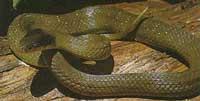 |
-
Common name of is derived from the newspaper (The Eastern Province Herald) that first noted its presence
-
Upper lip is reddish or orange for animals in the southern part of its range
-
It will rear up and flatten its neck when provoked - causes it to be confused with cobras or vipers
-
Although its bite will bleed profusely, the venom has little effect on humans
-
Its normal prey, mainly frogs, are not so lucky and will succumb quickly once bitten
|
|
Boomslang (Dispholidus typus) |
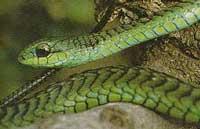 |
-
"Boomslang" means Tree Snake - these beautiful, shy snakes are almost always found in trees
-
One of the few snakes which has been recorded to cause a human death in southern Africa
-
A back-fanged snakes - has to "chew" the prey with fangs found at the back of the mouth
-
Most cases of human poisoning were reported by careless snake handlers - generally this snake will only bite under severe provocation
-
It hunts during the day - its huge eyes aid vision in the shaded treetops
-
The male is shown here - females are usually light brown or olive with white to brown bellies
-
They become quite long (max. 200 cm) but remain slender
|
|
Cape Cobra (Naja nivea) |
 |
-
One of the smaller cobras in the region (max. 170 cm)
-
Several colour phases, but usually it is dark yellow or copper coloured
-
The photo shows the speckled form, which is also found here
-
The venom is highly neurotoxic - this snake is not shy and will readily rear up to attack when disturbed
-
Death usually occurs from the rapid onset of paralysis - large amounts of antivenom is required
|
|
Rhombic Night Adder (Causus rhombeatus) |
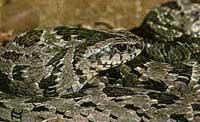 |
-
As the name indicates, this is a nocturnal snake
-
Rests up under logs and in termitaria during the day
-
Has poor eyesight and hunts mainly by smell
-
Although this snake is poisonous, it's venom is not very potent and causes mainly pain and swelling
|
|
Puffadder (Bitus arietans) |
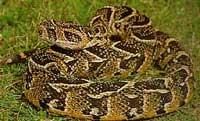 |
-
A thick, heavily built snake - reaches a maximum length of 120 cm
-
Females give live birth and can have between 20 to 40 young
-
Hunts by ambush, and is less likely to move out of the way than most other snakes
-
It hisses ominously when disturbed - hence the name "puff" adder
-
Front-fanged snake - when it strikes the fangs fold forward and inject venom into the prey on impact
-
The venom is cytotoxic and is usually deeply injected
-
About 60% of serious bites in Southern Africa are caused by Puffadders - responsible for most of the fatalities
|